Stuck on what wines to gift for Christmas? Cavit introduces an exclusive line crafted for restaurants and wine boutiques – the Bottega Vinai collection.
It presents a comprehensive array of wines from the region, all strictly D.O.C. The grapes are meticulously sourced from prime Trentino locations:
- Piana Rotaliana
- Trento hills
- Vallagarina
- Brentonico Plateau
- Cavedine Valley
- Roveré della Luna
- Valley of Lakes
Discover the 5 wines from this exclusive line perfect for Christmas.
Index:
- Bottega Vinai Gewurztraminer
- Bottega Vinai Chardonnay
- Bottega Vinai Sauvignon
- Bottega Vinai Marzemino
- Bottega Vinai Teroldego
- Cavit: Tradition and Innovation
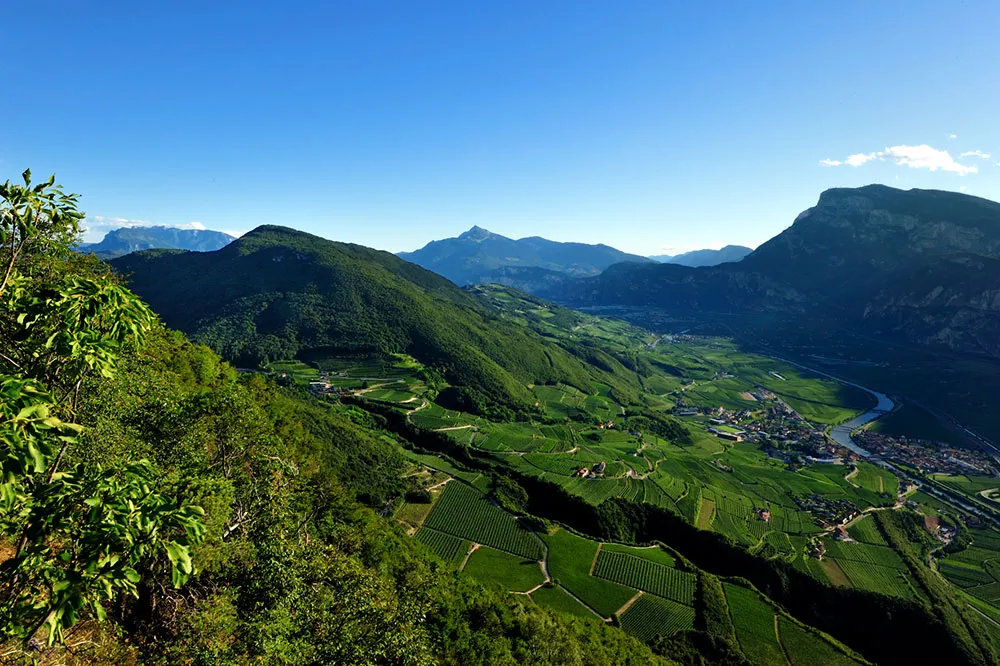
Bottega Vinai Gewurztraminer
Traminer is a grape variety originating from the Trentino-Alto Adige region, specifically from Termeno (South Tyrol, Tramin in German), where it has been cultivated since the 16th century.
It later spread to Alsace and some prominent German wine regions, such as Württemberg and the Palatinate, benefiting from their cool-temperate climates that enhance its aromatic qualities.
Production Area
The well-exposed and sunny hills of Roveré della Luna and the Adige Valley north of Trento, at altitudes ranging from 250 to 400 meters above sea level, provide an ideal environment for Traminer cultivation.
These vineyards are situated on an ancient cone with brown, shallow soils rich in gravel and a sandy-loam matrix. In the upper Adige Valley, instead, the vineyards are located on glacial deposits (moraines and cones), featuring sandstone, siltstone, marl, limestone, and dolomite. These moderately deep, sandy-loam textured soils are abundant in stones and pebbles.
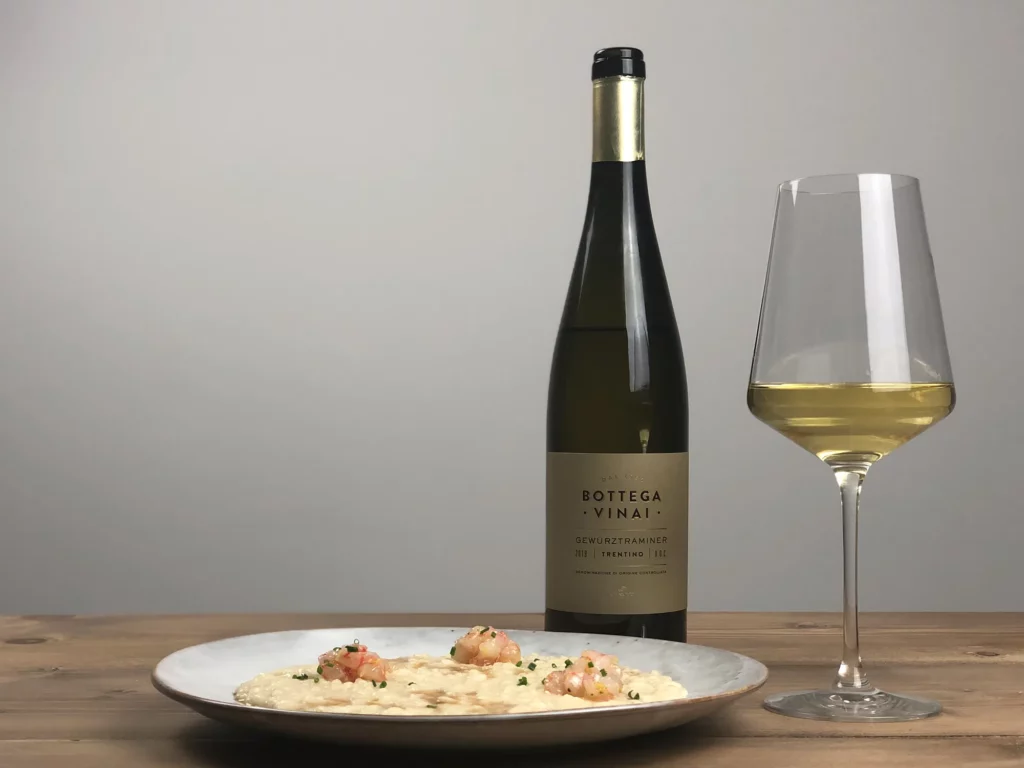
Winemaking
The grapes are hand-harvested at perfect ripeness, and after a meticulous selection, they undergo destemming and crushing. The resulting must remains in contact with the skins for a brief period at a temperature of 56 °C to extract its aromatic compounds.
Pressing is carried out with special care to avoid excessive color extraction, although the must may take on a characteristic coppery hue during this phase, which spontaneously disappears during alcoholic fermentation, assuming a golden yellow color with subtle greenish reflections.
Maturation
Following fermentation in stainless steel at a temperature not exceeding 20°C, the wine matures in tanks for 4-5 months before bottling.
Organoleptic Characteristics
Its luminous golden yellow color with brilliant reflections highlights its substantial quality.
Intensely aromatic on the nose, it reveals rich notes of tea rose and subtle hints of spices like thyme and juniper.
In the mouth, the wine is elegant, structured, and well-balanced, almost creamy. The rich aftertaste lingers with a long persistence, recalling aromas of rose, dried apricot, and pineapple.
Perfect Pairings
Perfect with savory tarts, fish-based appetizers, sauces, and first courses with vegetables or main courses featuring fish and white meats.
Bottega Vinai Chardonnay
Globally renowned, Chardonnay was introduced at the end of the 19th century in Trentino, where it found an environment so favorable that it now represents one-third of the entire productive potential of the province.
Production Area
The hills of Santa Margherita di Ala in Vallagarina and the Valley of the Lakes north of Lake Garda.
In the Santa Margherita area, vineyards are situated on ancient cones with brown, shallow soils rich in gravel and a clay-loam matrix.
In the Valley of the Lakes, the soils are moderately deep, alluvial in origin, enriched with gravel and a loam-silty matrix.
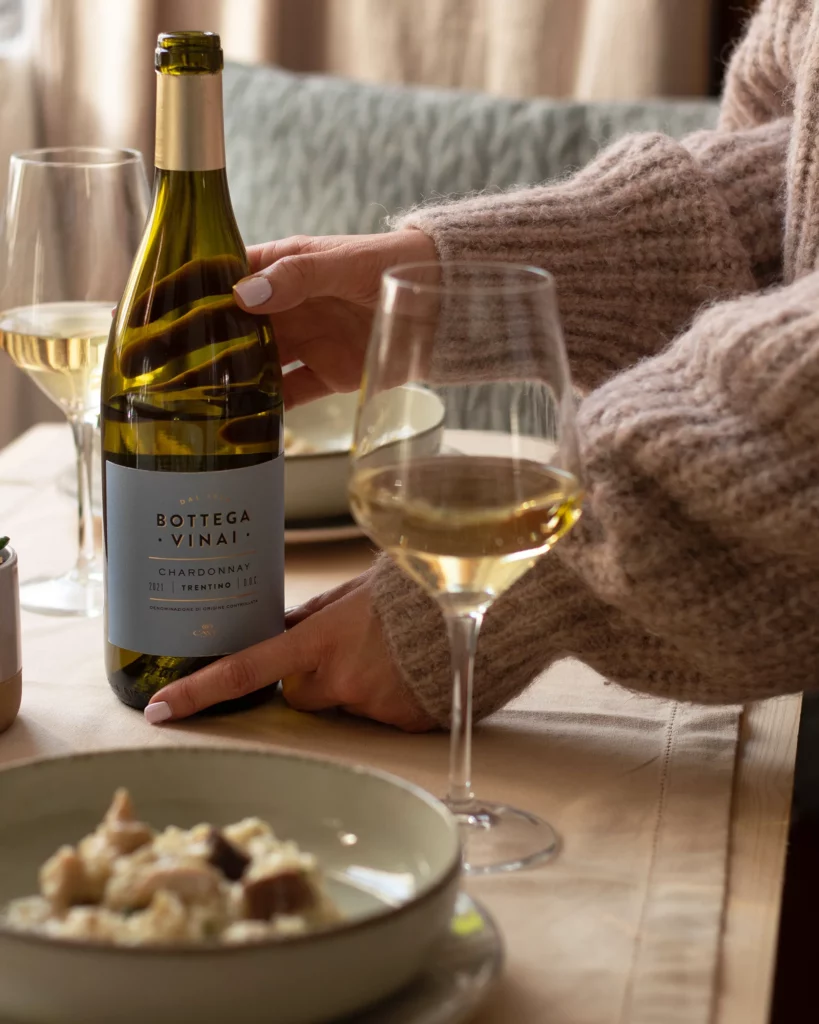
Winemaking
Hand-harvested at perfect ripeness, the grapes are immediately brought to the cellar for gentle pressing and destemming.
The must and skins are cooled at low temperatures and remain in contact for about five hours to optimize the aroma extraction.
Soft pressing of the pulp and skins follows to obtain the must, with fermentation occurring partially in French oak barrels and partially in stainless steel.
Maturation
Maturation occurs on lees: 30% in French oak barrels and 70% in steel. The wine is then cold-bottled, refining in the bottle before commercialization.
Organoleptic Characteristics
A straw-yellow white wine with greenish reflections.
Intense and rich on the nose, featuring notes of yellow apple, apricot, and pineapple. A subtle and enticing scent of patisserie from barrel aging.
Full and enveloping on the palate, showcasing excellent balance with a rich and persistent aftertaste.
Perfect Pairings
Salmon, Mushroom Risotto, Seafood Spaghetti, and Oven-Baked Sea Bass.
Bottega Vinai Sauvignon
Originating from the Gironde region in Bordeaux, Sauvignon Blanc made its debut in Trentino over a century ago.
This wine is distinguished by its finesse, savory profile, and an elegant, distinctive aroma that varies in intensity depending on the vintage.
Production Area
Nestled in the hills of the Valle dei Laghi, where a sub-Mediterranean climate prevails, offering mild temperatures both in summer and winter.
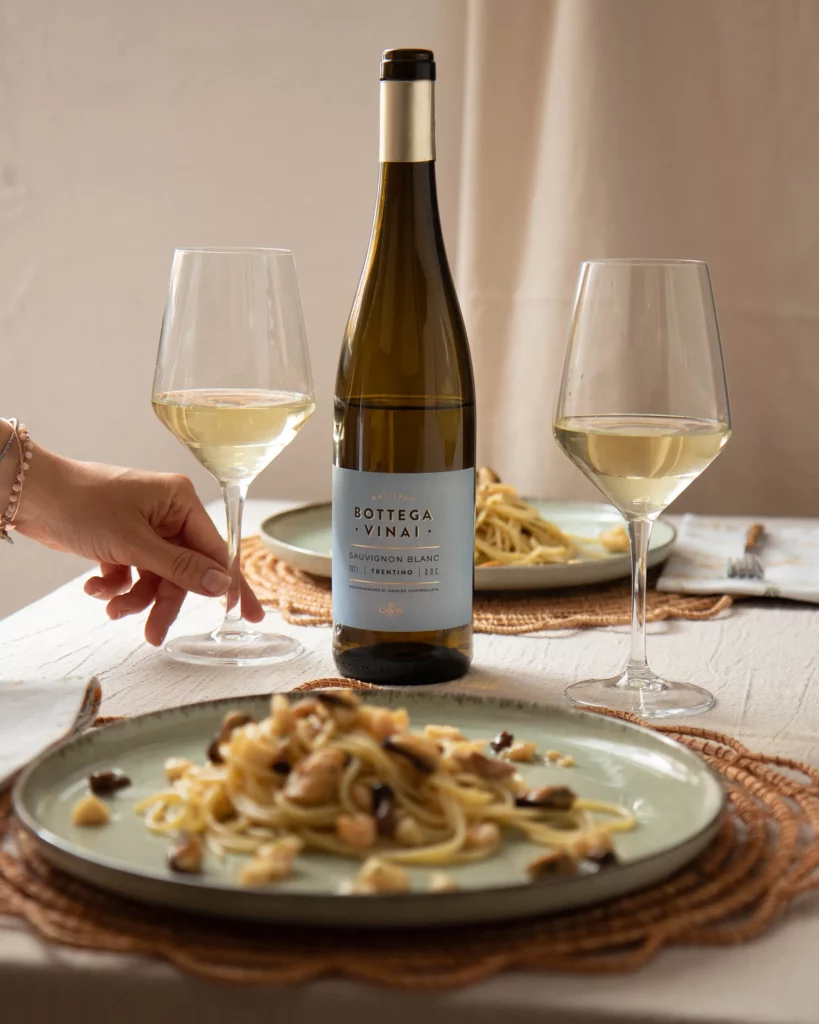
Winemaking
The grapes undergo a gentle pressing and destemming process.
A 12-hour cold maceration enhances aromatic extraction, followed by a delicate pressing and controlled-temperature fermentation.
Organoleptic Characteristics
A pale yellow wine with golden reflections, Sauvignon Blanc captivates with its subtle hue.
The intense aroma is supported by aromatic notes reminiscent of elderflower, fig leaf, and grapefruit.
The taste is dry, with a good body and a pleasantly zesty acidity.
Perfect Pairings
Indulge in the art of culinary synergy with Sauvignon Blanc. Ideal companions include spaghetti with clams, risotto with scampi, mixed fried fish, and grilled mushrooms.
Bottega Vinai Marzemino
Marzemino stands proudly as the flagship of Trentino’s viticulture, a grape variety synonymous with the picturesque Vallagarina.
Its renown traces back to Mozart, who extolled the “excellent Marzemino” in his masterpiece, Don Giovanni. This grape was even cherished by the troops of the Serenissima Republic of Venice.
Today, Marzemino is favored when dry yet gentle, striking a perfect balance between the fragrant exuberance of youth and the more traditional austerity.
Production Area
Thriving in Vallagarina, on both banks of the Adige River, specifically on the basalt terraces of Isera and in the “Ziresi” zone, known for its cherry orchards, in Volano.
The soils, brown and moderately deep, result from the mineralization of basalt (volcanic rock), enriched with clay (montmorillonites).

Winemaking
Vinification is in red with a one-week maceration in stainless steel tanks.
It then undergoes a six-month refinement in steel, preserving the floral characteristics typical of Marzemino.
The wine is bottled and ages for four months before reaching the market.
Organoleptic Characteristics
This intense and luminous ruby-red wine with violet undertones evolves gracefully with age.
The aroma unfolds with intense notes of wild violets and ripe cherries, accompanied by subtle hints of licorice spice.
Moderate acidity, coupled with balanced tannins, renders this wine exceptionally harmonious and well-rounded.
Perfect Pairings
Savor the harmony of Marzemino with flavorful appetizers, pasta dishes featuring mushroom sauces, roasted white meats, grilled fillet, and veal roasts cooked to perfection.
Bottega Vinai Teroldego
Teroldego, quite possibly the oldest quality grape variety cultivated in Trentino, has woven its story since the 15th century.
Its etymological origin remains shrouded in mystery. Some speculate it traces back to “Tiroler Gold” – the gold of Tyrol – owing to its intrinsic quality, prompting Cesare Battisti to dub it the “prince of Trentino wines.”
In 1948, its pioneers established the first Consortium for the Protection of Teroldego Rotaliano, and in 1970, they secured recognition as a Controlled Designation of Origin.
Production Area
Thriving in the Campo Rotaliano, north of Trento, within the municipality of Mezzolombardo.
The gravelly glacial soils from the Noce River faithfully replicate the hillside’s characteristics on the plain.
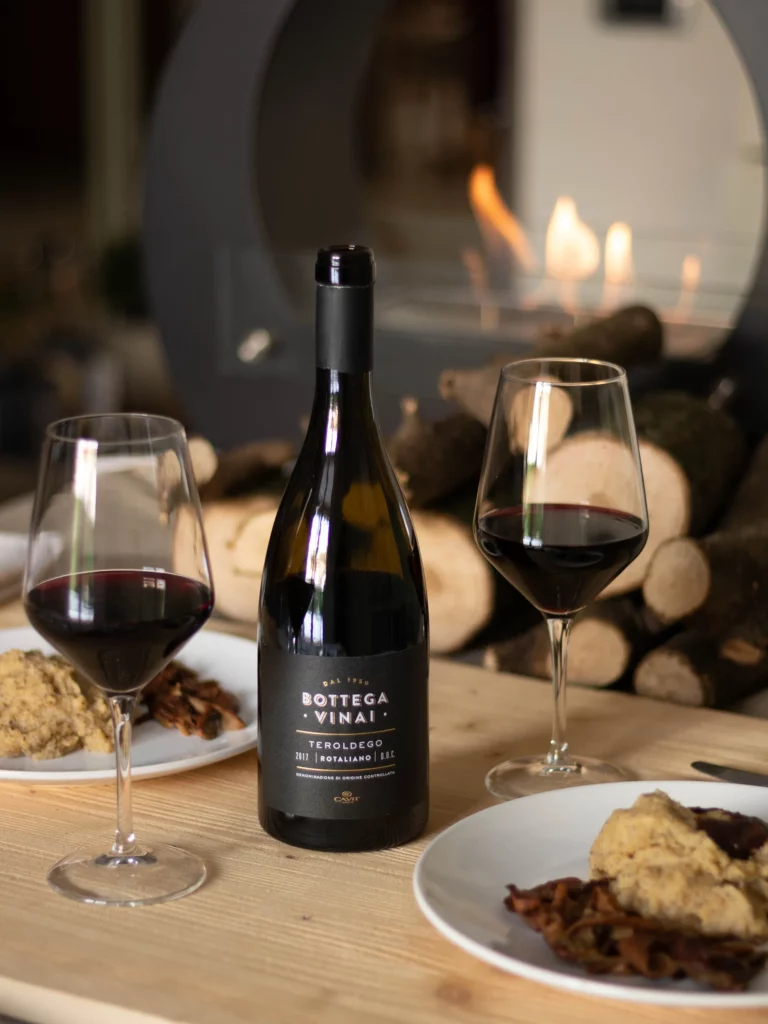
Winemaking
Crafted as a red wine, Teroldego undergoes an 8-10 day maceration in stainless steel tanks.
Maturation
Maturation takes place partially in barriques and partially in Slavonian oak barrels.
Organoleptic Characteristics
A deep ruby-red wine with pronounced and lively violet hues in its youth.
The aroma is clean, distinctly fruity with hints of raspberry, blackberry, and wild berries, evolving into an ethereal bouquet with maturation, offering a broad and personal spectrum.
On the palate, it reveals balanced tannins with a full and continuous structure. The taste is velvety, enveloping, full-bodied, and austere.
Perfect Pairings
Savor the essence of Teroldego with Trentino’s culinary delights – from the local “Tonco de Pontesel” to venison and polenta, veal stew, and mixed grilled meats.
Cavit: Tradition and Innovation
Cavit, short for Cantina Viticoltori del Trentino, resides in the heart of Trentino, Ravina di Trento. As a cooperative uniting 11 Trentino social wineries, it represents over 60% of Trentino’s vineyard area with 5,250+ associated viticulturists.
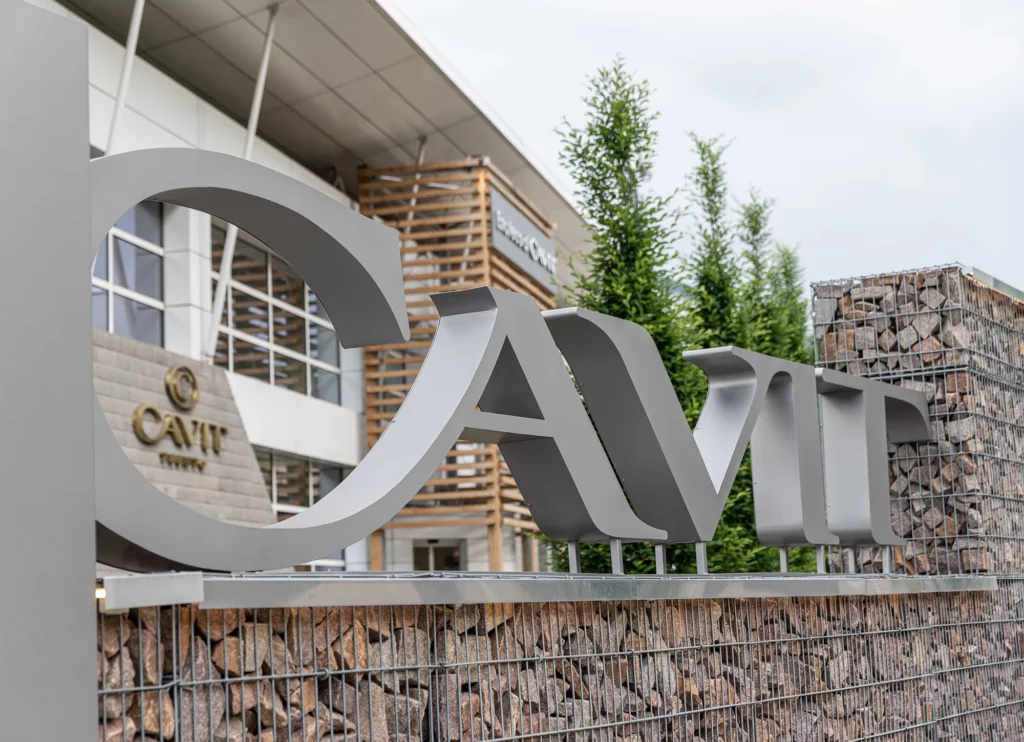
For over 70 years, Cavit has combined technological advancement and scientific research, emphasizing tradition, innovation, and environmental respect.
Their mission is to make quality wine an everyday pleasure, offering wines known for an excellent quality-to-price ratio and appreciated globally.
Amo la buona cucina e le tradizioni enogastronomiche italiane, per me vino e dessert non sono solo un contorno ma la parte più interessante del buon vivere.










